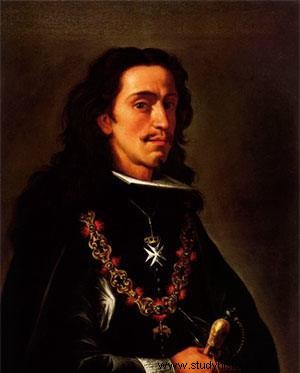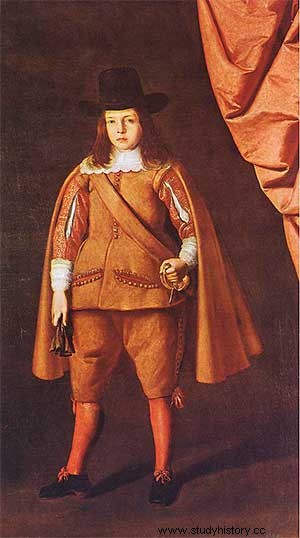On his fourteenth birthday, on November 6, 1675, King Charles II came of age . The queen regent managed to extend the mandate of Valenzuela (valid of the queen regent Doña Mariana of Austria), who obtained more palatial positions as well as the greatness of Spain. However, relying on the discontent of the nobility and the people, once a successful propaganda of sermons and pamphlets had been prepared, Don Juan José de Austria, brother of King Carlos II, would repeat the action of 1669 and after gathering an army of some 15,000 men entered Madrid. The so-called revolt of the greats or first pronouncement of modern times (December 1676) took place. The Council of State sanctioned the coup d'état and gave it effective power (January 1677). Valenzuela was exiled to the Philippines and Queen Mariana of Austria was confined in the Alcázar of Toledo. On November 19, 1679, the first marriage of Carlos II (18 years old) with María Luisa de Orleans (17 years old), who was the daughter of Felipe (Duke of Anjou) and niece of Luis XIV, took place near Burgos.
Government of Don Juan José de Austria

Don Juan José of Austria came to power with the halo of a savior hero, of a prince who was going to remedy the decline of Spain, however, his government coincided with one of the most critical moments in the Spanish economic evolution and the situation international policy. The reformist program was immediate and included various measures against administrative corruption, while a Board of Trade, Currency and Mines was created (1679) . However, the mandate of the bastard son of Felipe IV was immersed in very negative circumstances for any deep attempt to change the general situation of the country, such as:the bad harvests (1677, 1678 and 1679) that aggravated the crisis of those years; the scourge of the plague from Cartagena (1676); and the partial suspension of payments (1678), which prevented the promise of relieving his vassals of taxes from being fulfilled. The private could not even cope from Cartagena (1676); and the partial suspension of payments (1678), which prevented the promise of relieving his vassals of taxes from being fulfilled. The private sector could not cope with the growing cost of living, nor did it carry out reforms that would make the distribution of tax burdens more equitable, which would have forced it to challenge the interests of the aristocracy, the social group that had supported it to access power. In foreign policy, the Peace of Nijmegen was reached (1678) , thus closing a conflict initiated by France that would lead to a decrease in popularity in areas close to the military. His government was a reaction, appealing to the latent strength of the people and the support of the periphery, against the corruption and baseness that the Spanish Court had reached.
Government of the Duke of Medinaceli

After the death of Carlos II's half-brother, men succeeded each other in power who were not the result of an endorsement, but of the consensus of the different political forces that were represented in the Madrid court. A party headed by Don Juan Tomás de la Cerda, eighth Duke of Medinaceli, president of the Council of the Indies and since 1680, prime minister, was grouped around the king. In the interior, the application of some of the reforms planned by don Juan is due to him, paying special attention to trade with America and the protection of the textile industry . In 1680, a famous auto de fe was also celebrated in Madrid -collected in detail by the painter Francisco Rizzi- which testifies once again to the public manifestation of the Catholic faith.
In the monetary and financial field, the Duke of Medinaceli carried out the monetary reform of 1680, with negative repercussions on the economy . He also promoted, at the end of 1682, a reform in the administration of the alcabalas, a few percent and service of millions. Abroad, the disasters of the war with France, ended with the Peace of Basel (1684) , increased the general malaise, seeing Medinaceli involved in a series of palace intrigues that tried to bring him down. Aware of his lack of support, he requested and obtained leave to leave the government, retiring to Guadalajara in June 1685.
Government of Don Manuel Joaquín Álvarez de Toledo y Portugal, Count of Oropesa
He would be replaced by Don Manuel Joaquín Álvarez de Toledo y Portugal, Count of Oropesa, who since June 1684 already shared power with Medinaceli. During his government, a process of fiscal, administrative and ecclesiastical reform was launched, taking examples from the French administration . Measures were also tried to recover the industry. However, a series of scandals in the Government, the hostility of a part of the nobility, as well as the second wife of the monarch, Mariana de Neoburgo would force him to retire on June 24, 1691. He had tried to stop the decline and the financial disorder in Spain, without achieving the long-awaited economic recovery.
The financial situation during the decade 1690-1700 was very delicate. To the expenses of the funerals of the queen Maria Luisa, the wedding of Carlos II with Mariana de Neoburgo and the little silver contributed by the American fleets, the war of the Nine Years was added that would demand new disbursements. The count of Oropesa, of Austrian tendency, would return again to court in 1698 as President of the Council of Castile . In the spring of 1699, a subsistence riot in Madrid (the Los Gatos riot) would be the excuse for the Count's enemies to impose his dismissal and threaten new riots if he returned to power or measures inspired by him were taken.
Reign of Charles II
During the reign of Charles II we witness a development of the political power of the kingdoms and local oligarchies, serving this historical moment to coin the term neoforalismo , that is, of interventionism of the peripheral kingdoms with respect to the central power. During the last decades, the concept of neoforalismo has been submitted to a review process, paying some attention to the cooperative relations between the Crown and the kingdoms, but, above all, to the movements of political and social rebellion that took place during the reign of Carlos II. Some realities that related the different territories (Aragon, Catalonia, Valencia, Sicily and Sardinia) with the central government, through the systematic meetings of the Cortes, to address problems of security, taxation and political-social instability.
More complicated was the rebellion of the Italian city of Messina (1674-1678), capital of Sicily . The difficult economic situation, as well as the favor granted by the Monarchy and its viceroys to the Sicilian aristocracy, linked to Palermo, ended up eroding the foundations of Messina's loyalty. The attempt to curtail local privileges led to a slow process of degradation that finally led to the open rebellion of the city's aristocracy against the viceregal administration in 1674, thanks to the support of the French army. Until the signing of a general peace, such as the one concluded in Nijmegen (1678), the previous order of things was not restored and the withdrawal of the French allies, established in several cities and fortifications on the Sicilian coast, began. Finally, in Sardinia, the Marquis of Camarasa, viceroy of the kingdom, confronted the most independent faction in Parliament, which defended the reservation of public offices for the Sardinian nobility and the limitation of the royal bureaucracy. The restoration of royal authority was faster than in Sicily, but it was also mediated by a series of assassinations -including that of the viceroy himself-, executions and exiles.

